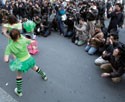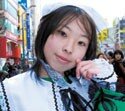Akihabara on the Run
Thanks to otaku culture, Akihabara is the symbol of “Cool
Japan.” But with developers moving in, will the geeks be left behind?
By Patrick W. Galbraith
 The saying goes that in Akihabara, you can find whatever you
desire. Tokyo’s Electric Town is a place where dreams and fantasy become
reality, not just for local otaku, but for the shoppers and tourists who come to
share their world. Yet what the powers that be want now is for the otaku to
disappear.
The saying goes that in Akihabara, you can find whatever you
desire. Tokyo’s Electric Town is a place where dreams and fantasy become
reality, not just for local otaku, but for the shoppers and tourists who come to
share their world. Yet what the powers that be want now is for the otaku to
disappear.
“There are three periods in Akihabara: past, present and
future,” says Takaya Kobayashi, a city councillor in Chiyoda Ward. “The past is
the history, the present the current pop-culture boom, and the future the
development of mega buildings and a contents industry.”
And he means to
expedite that process—with police force if necessary.
Kobayashi’s
views are emblematic of the political posturing that’s swept Akihabara since
the business community had its appetite whetted by the annual $3.5 billion
otaku-related industries. In a supreme irony, the very people who did so much to
give the area its newfound cool—the small shop-owners, the electronics
enthusiasts and, especially, the otaku of all stripes—are the ones with the most
to lose as Akihabara goes upscale.
Part of Tokyo’s downtown shitamachi
area, Akihabara gained renown in the 19th century for Akiba Jinja, a shrine
dedicated to fire protection. Although Japan Railways leveled the holy site when
they built the local train station in 1890, the “Akiba” moniker lives on as an
alternative name for the area. In the decades following WWII, the neighborhood
became a black market for transistor radio parts pilfered from occupying GI
forces (1940s) and then a market for appliances (’50s and ’60s), electronics
(’70s) and computers (’80s). By then, Akiba was already the largest electronics
shopping mall in the world, a futuristic hub for rare and innovative
products.
And then otaku started showing up.
The media implicated
such “deviant youth” in infamous crimes, such as the serial killing of four
young girls by "otaku murderer" Tsutomu Miyazaki in the late-’80s. As other
neighborhoods became less welcoming of otaku in the 1990s, stores catering to
the subculture, such as Shibuya model and figurine emporium Kaiyodo, moved to
Akiba, sparking a mass influx of hardcore fans. Normal folk stayed away, thanks
to media reports that the Aum Shinrikyo cult harbored “otaku” sociopaths in
Akihabara. Anime, manga and video games became the currency of the land; the
first high-rise building, the iconic Radio Kaikan erected in 1955, became a
shrine to ever-changing fandoms.
Fast forward 10 years, and those same otaku
who retarded Akiba’s growth became the impetus for its expansion.
“The
popular perception of otaku changed in 2005 with Densha Otoko, The Train Man,”
said Susan J. Napier, author of Anime: from Akira to Princess Mononoke. “It was
the first major television drama that had an otaku hero. The characters went to
Akihabara and it seemed fun and bright, not evil and dark.”
The supposedly true story of a lonely otaku who saves a woman being molested on a train, Densha Otoko is a modern retelling of the beauty and the beast fable. “Densha” seeks advice from his otaku friends, a pure-hearted bunch who get together online—and in Akihabara. One of their common meeting points, Pinafore, became a tourist magnet and helped inspire the maid café craze that persists to this day.
The number of maid cafés in Akiba increased by
nearly 2,000 percent after Densha Otoko, and TV shows featuring popular venues
such as @home Café grew by 685 percent between 2004 and 2006, according to the
website Kissa Navi. These figures have not gone unnoticed by filmmakers and TV
producers. Because Akiba has no restrictions on film crews, shooting costs are
minimal, and producers are treating the area as a discount alternative to Ginza,
Shibuya or Roppongi.
The numbers illustrate the effect the “otaku boom”
has had on Akiba: 10 percent of visitors come to buy electronics, 25 percent to
buy computers and 30 percent to pursue otaku hobbies, but the remaining 35
percent are sightseers, according to an NHK survey. Akihabara ranked among the
top five places foreigners wanted to visit in Japan in 2007, causing a
fundamental shift in government policy. Rather than shun otaku, Yokoso! Japan
now offers weekly “Cool Akihabara” tours, and the JNTO actively markets the
“Otaku Mecca.” Other neighborhoods can only look on in envy: longing to reclaim
the cachet of “Cool Japan,” Shibuya's mayor announced last year that he wanted
his city to be more “like Akiba” and import maids.
The culmination of
this came when former Minister of Foreign Affairs Taro Aso "came out" as an
otaku in Akiba in 2006. Aso's highly publicized bids for the post of prime
minister were heavily salted with references to Japanese pop-cultural supremacy
and harnessing the soft power of Japan’s contents industry.
“We invented
otaku and should take pride in that fact,” he said in a TV
appearance.
With so much economic, social and political momentum, leaders
accelerated decade-old plans to redevelop Akihabara into a contents-industry
showcase and a “Japanese Silicon Valley." NTT Urban Development, Daibiru and
Kajima Corporations received heavy subsidies to push the project to completion.
 The iconic Daibiru tower sprung up on the north side of Akihabara
station in 2005, the same year the Tsukuba Express to Ibaraki made northeast
Akiba a commuting stop for middle-class suburbanites, and Japan’s largest
Yodobashi Camera set up shop next door.
The iconic Daibiru tower sprung up on the north side of Akihabara
station in 2005, the same year the Tsukuba Express to Ibaraki made northeast
Akiba a commuting stop for middle-class suburbanites, and Japan’s largest
Yodobashi Camera set up shop next door.
When the massive UDX and
Crossfield complexes were completed in 2006 behind the main Chuo Dori drag,
joined in 2007 by the Fujisoft tower midway between the Akiba-side and
Tsukuba-side developments, the redevelopment trifecta was effectively complete.
As a headline in the Nikkei newspaper had it: “Otaku Ceding Domination of Famous
Electric Town as Development Lures IT firms.”
Inflating land prices show
the sharp effect of Akiba’s growth. The value of property near the station's
Electric Town exit increased 20.4 percent between 2006 and 2007. On the back
streets near where the first maid café was founded in 2001, land prices have
risen by 10 percent a year over the past five years, according to the Ministry
of Land, Infrastructure, and Transport.
Despite talk of long-time
residents being muscled out by cutthroat taxes and competition, Kobayashi and
other figures take pride in the changes they in part orchestrated.
“There
is already a salaryman culture here,” he said. “Families, women with children,
will come to Akihabara as the Tsukuba Express becomes more
affordable.”
Around 5,000 people live inside the limits of the Soto-Kanda
district, which contains Akihabara Electric Town. Many have already raised
concerns about rowdy weekend gatherings when the streets are closed to vehicular
traffic and otaku can freely “cross-play,” or costume as an anime character of
the opposite sex, and perform otagei, the otaku art of dancing and chanting
before an idol singer. These concerns have only been exacerbated by the arrival
of families touring Akiba or coming in on the Tsukuba Express.
 “The things that are out of the ordinary for those who visit here
to play are ordinary for the people who live here,” said Kobayashi, who also
tracks commercial and otaku activity in his free magazine Akibatsu. “These are
the people that file complaints, and we have to respond with police. If you are
dancing or having a photo shoot in the street, people can’t get by and are upset
about that.”
“The things that are out of the ordinary for those who visit here
to play are ordinary for the people who live here,” said Kobayashi, who also
tracks commercial and otaku activity in his free magazine Akibatsu. “These are
the people that file complaints, and we have to respond with police. If you are
dancing or having a photo shoot in the street, people can’t get by and are upset
about that.”
Now when Chuo Dori is closed to cars, the police patrol on
foot to break up idol-singer performances and photo shoots, otagei circles and
cross-playing otaku dance routines. Officials say otaku are loitering, littering
and disturbing the peace. Forget their bringing in the tourists—that, obviously,
is the past.
The heavy-handed response by law enforcement is in part a
result of conflating the issue of rising crime with complaints against otaku.
Alarming media reports claim maid services are being taken over by gangs who
flout the official limit on yakuza activity and enter Akiba proper to force
girls into “compensated dating.” Shoplifters posing as otaku carrying the
stereotypical daypack are drawing scrutiny, as are prominent pirate software
dealers from China.
Confrontations between police and otaku have been
increasingly heated, and Kobayashi among others have vowed to instill control.
The situation came to a head when Liberate Akihabara, a mass otaku cooperative,
staged an unprecedented 500-fan march in June 2007 after weeks of
protests.
“The police have been out harassing the cosplayers,” said
Syuu-chan, the group's 28-year-old leader. “We want to make a paradise for
otaku. Recently, that isn’t Akihabara.”
While otaku struggles seldom make it into the mainstream media, local news
sources are increasingly chronicling the goings-on. And there are signs that the
attention is having an effect. Plans are being hastily drafted to curb the
building frenzy in Akiba.
“There is a new law in the works for Akihabara
that will limit the height of new buildings,” explained Kobayashi. “However,
that law cannot go into effect until 2009, so rapid growth will increase in 2008
as contractors rush to get buildings up.”
Will the otaku persevere that
long? Patrick Macias, author of Cruising the Anime City, has suggested they will
instead emigrate to other, less visible corners of Tokyo where society won’t
bother them. He summed up an April 2007 article in The Japan Times by saying
“the true face of otaku culture is hardly ready for prime time.”
Experts
say that for the very sake of the neighborhood’s vitality, policymakers must
reconsider the contradictory course of developing a playground of “Cool Japan”
that runs off the otaku that enlivened Akiba and brought the global and media
interest in the first place.
“You have figures being sold in a store
right next to high-tech parts, and that coexistence of
the industrial and
creative is one of the special characteristics of Akihabara,” said Ichiya
Nakamura, a member of Keio University’s Research Institute for Digital Media and
Content. ”It is precisely because that hard element is complemented by the
creative hobby element that incredible developments occur here.”
Geek Love
From guns to
games to “little sisters,” these otaku hotspots are true Akiba originals
Azone Labelshop & Weiss Brau Residenz
Adult play is a serious thing, and nowhere is this clearer than one
decrepit building forgotten on the backstreets of Akiba. No elevators or
escalators here, just a narrow, dimly lit flight of stairs leading up to Azone
on the second floor, a store specializing in expensive dolls collected, dressed
and loved by its enigmatic “dollar” patrons. The other extreme is on parade two
floors up in a weapons shop importing western military implements.
1-5-7 Soto-Kanda, Chiyoda-ku. www.azone-int.jp; www.wbr.co.jp
Heroine Special Effects Research Center
Next door
to Don Quixote in an unassuming basement, this shop has classic otaku flavor.
The owner loves sentai, or old ranger superhero shows, and mixes these with his
other interest— pornography—in amateur “hentai sentai” productions. Every bit as
esoteric and random as it sounds, this hidden gem is the place to pick up rare
SF movies and artifacts, or to “research” what a ranger show might be like if
the heroes getting slapped around by the evil-doers happened to be women.
4-4-9 Soto-Kanda, Chiyoda-ku. www.heroinetokusatsu.net
AKB48 Stage
AKB48 stands for 48 idol singers, or
cutesy rank amateurs, divided into three 16-member units. The kinetic storm of
idol energy and otaku response happens every weekday night from 7pm and weekends
1 and 6pm. Tickets are limited to one per person (¥2,000 for men, ¥1,000 for
women and children under 18). There is no reservation system and no online
booking; start queing in front of Don Quixote as early as possible—the line is
blocks long as early as 5am on weekends.
Don Quixote 8F, 4-3-3
Soto-Kanda, Chiyoda-ku. www.akb48.co.jp
HEY:
Hirose Entertainment Yard
Sandwiched between Sofmap and Akky Duty
Free on Chuo Dori, HEY is the second home of some of the most hardcore gamers in
Akiba. Both new and forgotten titles can be found here, and Melon Books in the
basement offers doujinshi amateur comics. A left at the intersection past Akky
and a right at Asobit City-Character leads to Super Potato, a haven for buying
retro arcade games with an ’80s-style arcade on the fifth floor.
1-10-5 Soto-Kanda, Chiyoda-ku. www.taito.co.jp/gc/details/57.html
Nagomi “Little Sister Café”
As the name implies,
this is not a standard maid café, but a place where the staff play the character
of little sister. They cheerfully welcome “big brother and sister” home, play
games and have capricious mood swings. Pretty much like being home, only you
have to pay them for it—and otaku gladly do. If the family drama proves too
much, Bar Zeon and Bar Earth Forces pay homage to the seminal Gundam series on
the fourth and fifth floors.
1-8-4 Soto-Kanda, Chiyoda-ku. www.nagomi.tv/access/index.html
Asobit City Hobby
One of the host of Laox’ Asobit
City shops, each floor targets a different niche. The sixth floor is for
military otaku, who buy pellet guns and protection and then head up to the
shooting range on the seventh floor to unleash the fury of the ages. Guns can’t
be rented, but you can bring one from home.
1-15-18 Soto-Kanda,
Chiyoda-ku. www.akibaasobit.jp
Little TGV
Otaku love for trains is well
documented, but only in Akiba would that be enough to carry a themed cafe.
Little TGV boasts waitresses costuming as train conductors, engineers,
attendants and in-car sales staff. They say “Welcome aboard, and thank you for
riding” when you walk in and promptly dispense a ticket from the wicket (cash
register). The culinary spread includes famous foods from rail stations across
Japan. The click-clacking of trains can be heard on the train-only soundtrack,
and a video recording of scenery viewed from a train window is broadcast on a
large monitor.
4F, 1-10-5 Isami, Soto-Kanda, Chiyoda-ku. http://littletgv.com




/https%3A%2F%2Fassets.over-blog.com%2Ft%2Fcedistic%2Fcamera.png)
/https%3A%2F%2Fstorage.canalblog.com%2F48%2F26%2F279158%2F39751138_o.jpg)